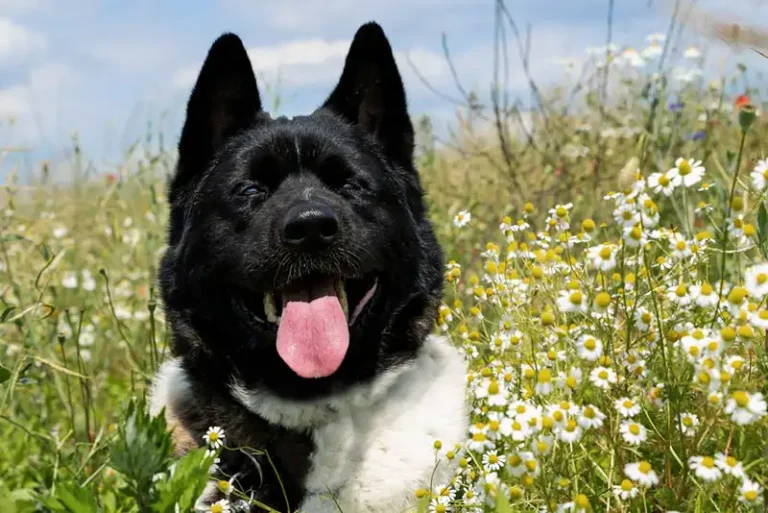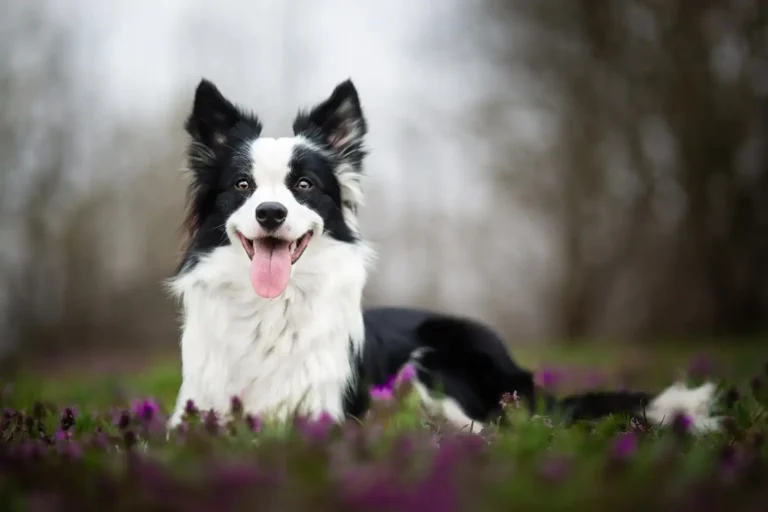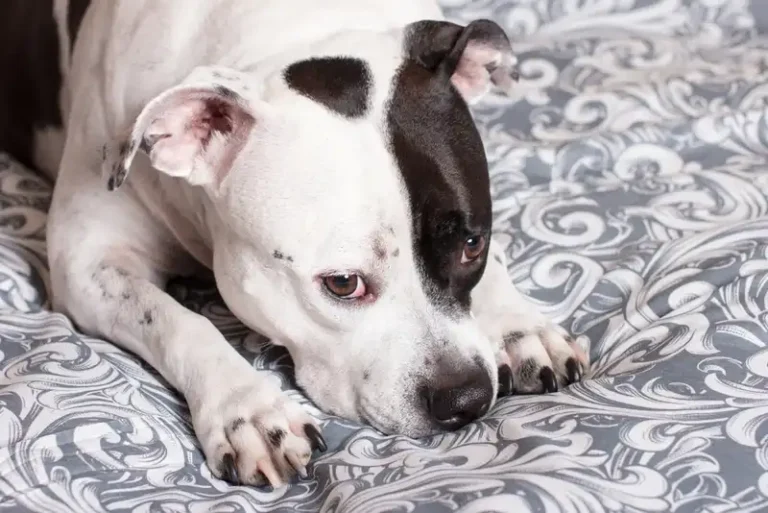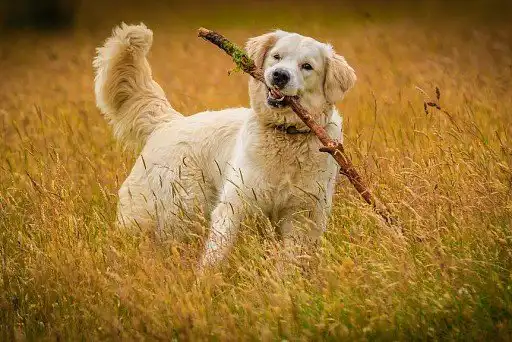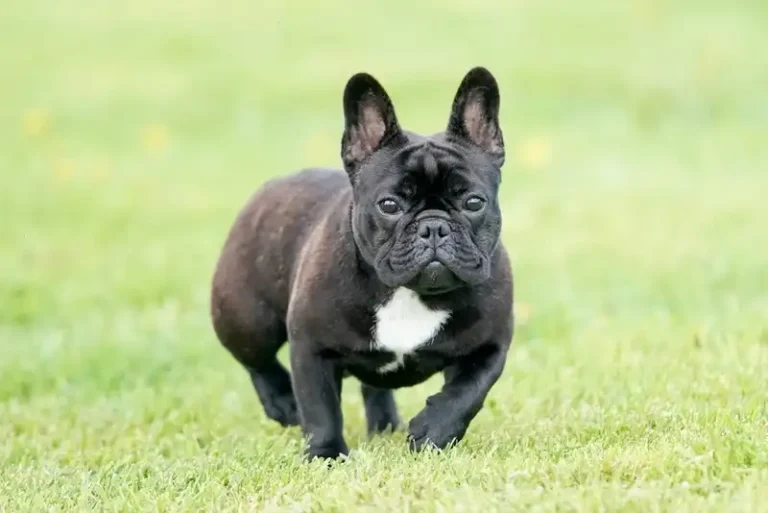Basic Facts About Italian Greyhounds
Country of origin: Italy
Size: miniature
Weight: 2.7-5 kg
Height: 32-38 cm
Age: about 14 years
FCI breed group: sighthounds
Basic Facts About Italian Greyhounds
A distinctive feature of this breed is the trembling of the whole body. It is believed that this condition is either a consequence of emotional overexcitement or hypothermia.
Italian Greyhounds are used to expressing their love for their owner tactilely: they love to hug, lick, and lie on a person’s lap.
Many dog owners are sure that their behavior often resembles that of cats: they like to climb high (on the backs of sofas and armchairs, on windows, even on tables), rub against the owner’s legs.
Despite the apparent fragility of their constitution, Italian greyhounds are very hardy and athletic. They are capable of developing quite a high speed – 40 km/h. These animals successfully participate in dog racing.
The Italian Greyhound has a very well-developed hunting instinct. With quality training and coaching, this dog can still hunt various small game: rabbits, hares, partridges.
Story
Scientists are confident that the breed has existed alongside humans for about 2,000 years. Archaeological excavations indicate that dogs in ancient times lived on the territory of such modern states as Greece and Turkey. Evidence of this is the numerous images of animals on vases and bowls. In addition, there are many drawings of these dogs in the palaces of the pharaohs of Ancient Egypt.
There are many legends about the ancestors of modern Italian greyhounds. One of them tells how the Persian king Cambyses, after conquering Egypt, brutally killed all the relatives of the pharaoh. Only his youngest child, a boy, he ordered to be thrown to death in the desert. A skinny dog ran behind the cart that was taking the pharaoh’s youngest son. It was she who barked, driving away wild animals from the baby with her ringing voice, and warmed him with her warmth on a cold night. The loud barking of the animal helped the servants find the pharaoh’s surviving son in the morning.
Queen Cleopatra was very fond of dwarf hunting dogs. It is known that she gave several of these dogs to Julius Caesar.
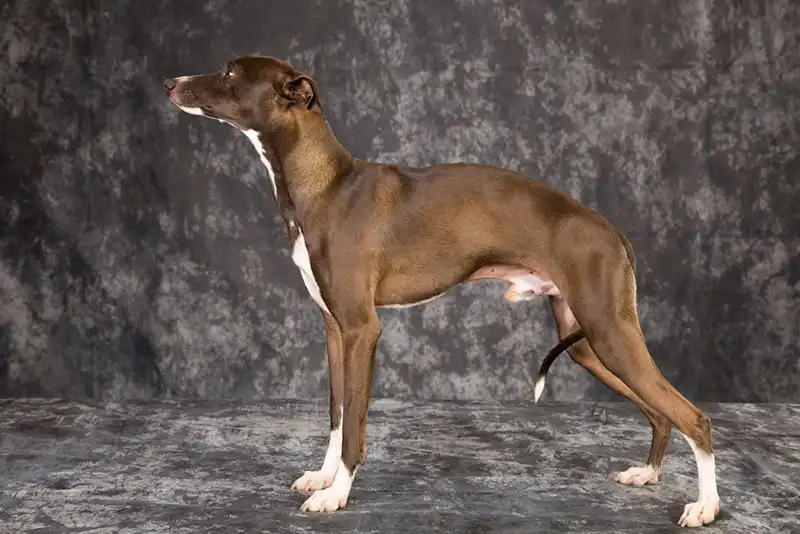
Miniature greyhounds were brought to European countries during the era of Roman conquests – approximately in the 5th century BC. It was during this period that the formation of the breed began. Italian greyhounds became the first dogs classified as decorative.
The miniature dog was used at that time as a hunter of small game – rabbits and hares. This is where the modern name of the breed comes from. The French word “lièvre” translates as “hare”. In addition, the pets could catch rats in the houses of their owners.
Italian greyhounds were loved by crowned heads. For example, Frederick the Great, Queen Victoria, Anne of Denmark, Henry VII. History tells us that an African king named Lobengula exchanged 200 heads of cattle for one small greyhound.
These dogs were brought to our country from France. Catherine II loved them very much. It was during her reign that the pets became popular among the Russian nobility. References to her Italian greyhound named Zamira can be found in the Empress’s letters.
At the beginning of the 19th century, the breed almost disappeared. Work on its restoration began in England. At that time, breeders gave preference to animals with a large number of white spots or white individuals. Later, they began to breed dogs with a solid red color.
The first Italian Greyhound, named Lilly, was registered with the American Kennel Club in 1886.
The breed’s appearance was finally formed in the 20s and 30s of the 20th century. This was facilitated by selection activities, during which pets were crossed with whippets and miniature pinschers . The work carried out helped restore the population of animals that had almost completely disappeared at the turn of the century due to numerous matings with closely related breeds.
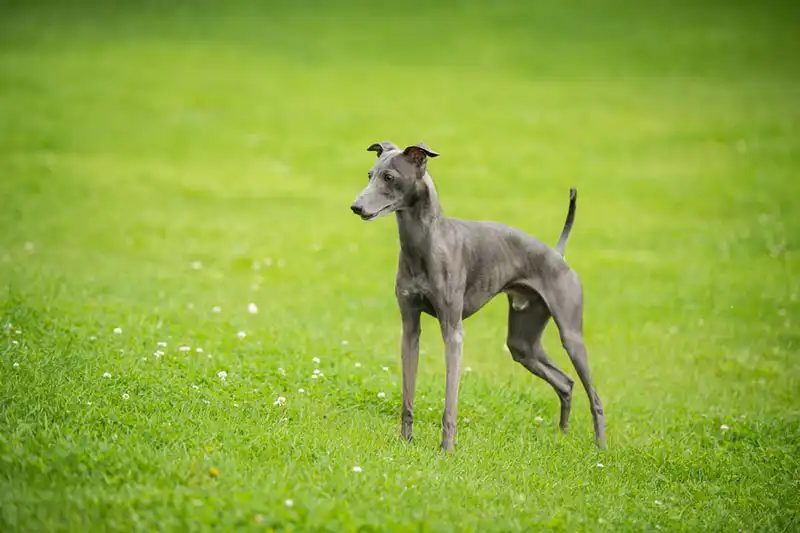
Description of the Italian Greyhound
The Italian Greyhound is a miniature dog. Its other name is the Italian Greyhound. It is characterized by an elegant, harmonious build and graceful movements.
Its slender body is square in shape. The length of the body, according to the standard, should be slightly less than the height at the withers.
The wool of representatives of this breed is allowed only short. The presence of feathering is considered a significant defect.
Head
In the Italian Greyhound, it has an elongated shape. The length of the head should be approximately 40% of the dog’s height.
The skull appears flat. The main lines of the muzzle are parallel to each other. The transition from the forehead to the muzzle is poorly defined. The cheekbones appear flat.
The Italian Greyhound’s nose is preferably black. The nostrils are wide and open.
The lips are thin, not pendulous. Their pigmentation is well expressed. According to the standard, they are painted black.
The jaw has an elongated shape. The teeth are strong and powerful. Their size fully corresponds to the dimensions of the animal. The bite should be scissor-like.
Eyes
The Italian Greyhound has rounded eyes. The eyelids are tightly fitting and pigmented black. The eyes are not set very deep. The preferred color of the iris is dark brown.
Ears
They have a triangular shape. They are set quite high. They are erect. The edge of the ear hangs down. Their size is small. The ear cartilages are thin.
If the dog is in an excited state, the ear rises on the cartilage.
Neck
It has a cone shape. The muscles are well developed. The transition to the withers is sharp, clearly visible. It is noticeably curved at the throat and in the upper part.
The length of the Italian Greyhound’s neck is equal to the length of the head. Dewlaps on it are not allowed.
Frame
Has a square shape. The back should look straight and have a slightly noticeable bend in the waist area. The Italian Greyhound’s chest looks wide. It is lowered approximately to the level of the elbow joints. The croup is muscular and slightly sloping.
Tail
It is set low. It is thin along its entire length, even at the base. It tapers even more towards the end. The Italian Greyhound carries it low. It is straight to about the middle, the second half of the tail bends downwards.
The dog usually holds its tail bent and carried between the hind legs. The hair on the tail is thin and short.
Limbs
The front legs of the Italian Greyhounds look thin and dry. They are set strictly vertically. The shoulder blades look sloping and moderately muscular. The elbows are not turned out to either side. The hind legs are also thin and graceful.
The paws of the dog’s front limbs are almost oval in shape, while the hind limbs are more like a circle in shape. The fingers are moderately curved. Their size is miniature. The pads are well pigmented, colored black. The claws match the color of the paws. White claws are acceptable in this case.
Movements
The Italian Greyhound moves springily and harmoniously. A prancing step (with the limbs raised high) is considered a significant defect. When the animal switches to a gallop, it begins to move as quickly as possible, jumping sharply.
Wool cover
The Italian Greyhounds have short and rather thin fur on all parts of their body. Elongated fur and feathering are a fault of the breed.
Italian Greyhound Coloring
According to the standard, the basic types of coloring for such dogs include solid colors:
Redheads;
Gray;
Blue;
Black.
Any shade of these colors is also acceptable. White markings may be present on the chest and paws.
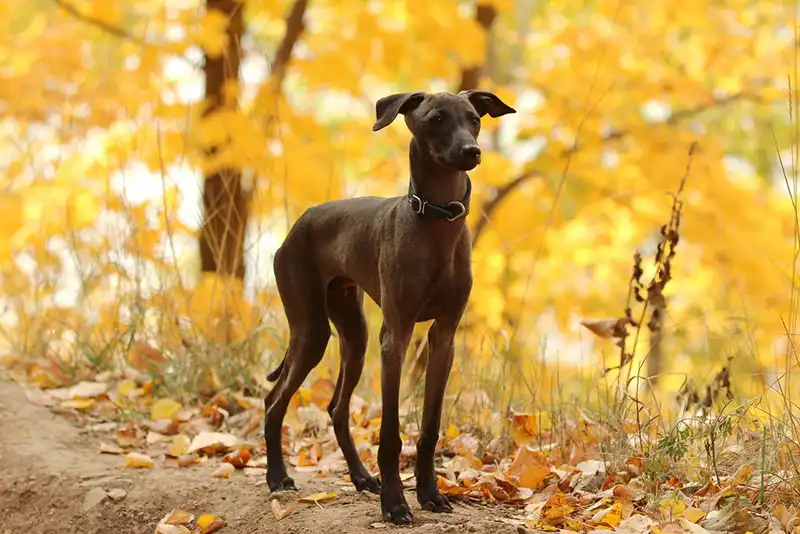
Size and weight
According to the breed standard, the ideal height for an Italian Greyhound is considered to be 32-38 cm. The maximum weight for males and females is 5 kg.
The character of the Italian Greyhound
The Italian Greyhound is ideal for the role of a companion dog. It is very attached to a person, constant contact with him is important to it. It cannot be alone for too long. It is ready to fulfill any desire of the owner, strives to follow him everywhere.
Italian Greyhounds have a high level of intelligence and learn new information quickly.
They are energetic and active. They need regular physical exercise. They love to run and jump. Italian greyhounds are regular participants in dog racing.
- Quite playful . They love various toys, especially soft ones.
Despite its agility and love for sports, this dog loves comfort and warmth. That is why it can often be seen basking in a soft blanket on a cozy sofa.
Animals are very emotional and experience any changes in their lives extremely painfully. They usually react negatively to a change of home, and especially to a change of owner. They do not like screams and noise in the house.
Aggression is not typical for the Italian Greyhound. It usually starts barking when it is very frightened. Its guard qualities are averagely developed.
With strangers, they behave calmly. They do not show aggression towards other dogs. They like to meet everyone who walks on the dog playground. This breed needs early socialization, otherwise they can become overly timid and shy.
Obeying the hunting instinct, the greyhound often chases small animals. It is necessary to wean the greyhound from this bad habit from a very early age.
- Sometimes pets like to bark . Their voice is shrill and ringing.
They adore all members of the family they live with. They are calm with children. However, it is important for parents to explain how to behave with their pet: they should not intentionally hurt them or take away their food. This touchy dog will never tolerate a disdainful attitude towards itself. It often shudders from sudden touches.
Italian Greyhounds are inquisitive. They show interest in everything that happens around them. When outdoors, they will explore new smells, sounds, people, and other animals.
- They don’t like rain and cold and often refuse to go for a walk in such weather.
Often the dog’s behavior is very reminiscent of a cat’s: the Italian Greyhound loves to climb onto the backs of chairs and sofas, sit on the windowsill, watching what is happening outside. Owners should always make sure that it does not fall. The breed is often diagnosed with bruises and fractures of the limbs due to its great love for heights.
They need long walks and training. It is better to walk the dog in a fenced area, since often the pet, obeying the hunting instinct, can run away, chasing some animals. In addition, despite their small size, Italian greyhounds can jump high and easily overcome a low fence. They love to dig holes during walks.
Upbringing
Italian Greyhounds are dogs that require a patient, balanced, but persistent owner. After all, any dog needs an authority figure that it will obey in everything.
To prevent your pet from chewing shoes, picking up trash from the floor, barking for no reason, and jumping on people, you need to train it regularly. Any behavior that you consider incorrect in a dog should be corrected immediately. You can start training the animal from the first days of its appearance in the house.
A puppy at the age of 1.5-2 months is already capable of mastering basic skills. It is necessary to accustom it to its nickname, show it its sleeping place and dishes, start putting a leash and collar on it.
It is recommended to choose a simple, short name for the baby. It is better if it consists of 1-2 syllables. Such a nickname is easier for the owner to pronounce and easier for the puppy to remember.
Every pet owner must define the boundaries of what is permissible for themselves: if you are not ready for the dog to beg for food from the table, sleep on your bed, chew your shoes and furniture, then do not allow it to do this from the very beginning. Having pitied the baby several times and let him sleep on the owner’s bed at night, after he grows up, you will no longer be able to explain to him that he should sleep only in his own place and not ask to go to the owner.
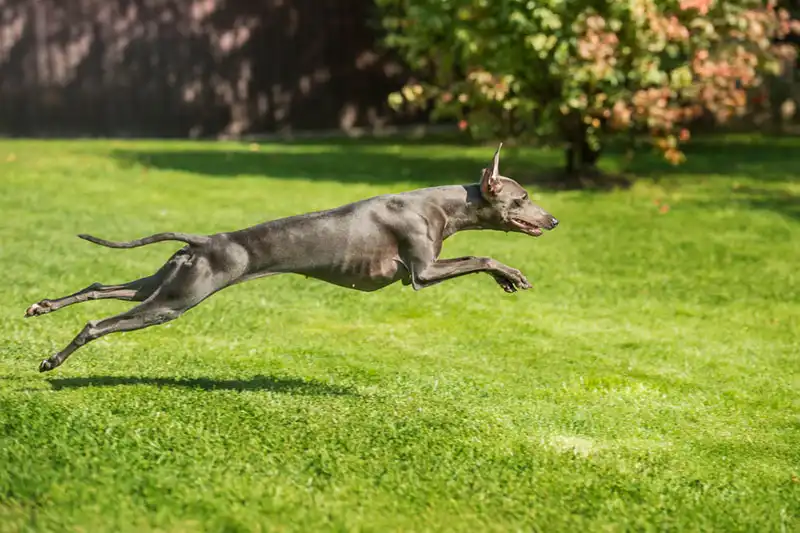
It is better to remove all objects that are dangerous for the baby, such as sharp and heavy ones. It is advisable to close the sockets with special plugs. It is also better to remove flower pots from sight. Pay special attention to indoor plants that are dangerous for dogs. It is better to get rid of them altogether.
Buy your pet special brushes for combing, claw cutters and a toothbrush. A finger cot for cleaning teeth is quite suitable for a miniature Italian greyhound (you can buy a regular child’s one, not a dog’s one).
It is necessary to socialize the dog from an early age. It needs to be accustomed to the company of people and other pets. Otherwise, the animal will become timid.
Training is a regular process. The dog is given enough time. It is desirable that the classes take place daily. They can be held both at home and during walks. It is imperative to use incentives. It is important to use healthy food as treats, for example, dry dog food . You should not reward the dog with products that are harmful to it: sausages, salami, sweets, pastries.
It is not recommended to raise your voice or scold the Italian Greyhound during training. These dogs are very emotional and easily offended.
With a puppy, you need to train very little – from 10 to 15 minutes. An adult can train longer – about half an hour. In any case, the owner must learn to understand the mood of his dog: as soon as he begins to reluctantly respond to commands , get distracted, it is better to stop training. This means that he is tired.
Find a quiet, secluded place for training. This way the dog will have fewer distractions – extraneous sounds and noises, other pets and people.
Italian Greyhound Maintenance
The Italian Greyhound is a dog that is ideal for an apartment. It is miniature in size, so it can be kept by people living in a small space.
True, you will need to walk her a lot and for a long time. You will also need to find a fenced place for regular jogging and physical exercise.
The pet’s fur is very short. It requires minimal care. The dog is combed 2-3 times a week with a silicone glove brush. The opinion that the Italian Greyhound does not shed at all is wrong. The breed does shed, it’s just not very active, so the fur is practically invisible at home.
It is not recommended to wash the animal often. In addition, you should not use shampoos for this: the dog’s skin is prone to dryness and irritation. You can wash it after a walk with ordinary warm water. In the autumn-spring period, when it is wet and dirty outside, the paws and belly will have to be washed daily. In the summer, it will be enough to simply clean them from dust and sand with a napkin.
You need to take care of your teeth quite carefully. Accumulated plaque and formed tartar provoke inflammation in the oral cavity – periodontosis. To prevent this from happening, it is advisable to clean your teeth daily with special toothpastes and brushes (or finger cots).
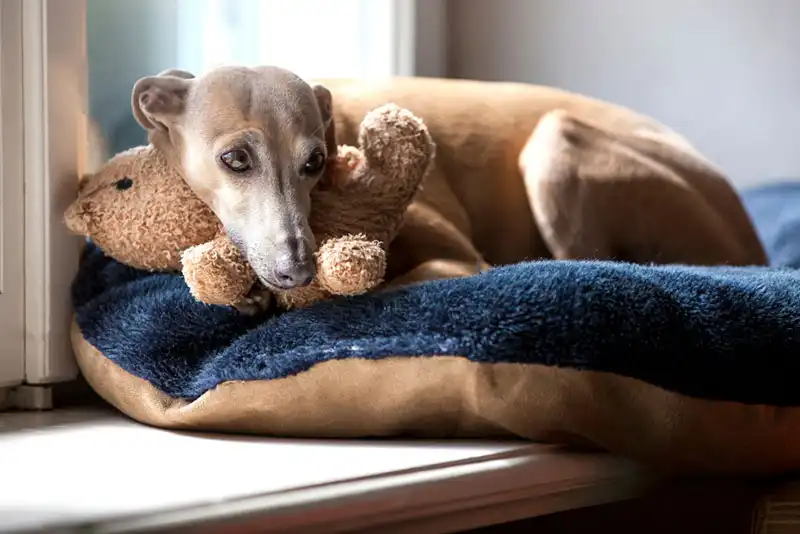
Even an adult Italian greyhound can be trained to go to the toilet in a tray or on a diaper. The animal is trained to do this from an early age.
The pet’s claws are trimmed as needed. Some dogs’ claws wear down on the asphalt themselves and do not need trimming. Others have their claws removed using claw cutters.
A specialist will show you how to properly cut a claw so as not to damage a blood vessel or nerve endings.
Dogs’ ears should be cleaned with veterinary lotions. It is not recommended to use human products for the procedure: hydrogen peroxide, boric alcohol, baby creams and powders.
The animal’s eyes need to be cleaned from the mucus accumulated in the corners as needed. It is advisable to use special dog lotions or regular warm water for the procedure. Cotton wool should not be used to clean the eyes, since its microparticles can remain on the skin, causing irritation. It is better to use cotton pads for this.
The pet is accustomed to any hygienic procedures from an early age. Such manipulations should be carried out in a calm environment, quietly and kindly talking to the dog. After each successful attempt, the dog is encouraged: praised and given a treat. For the animal, hygienic procedures should be associated only with positive emotions.
Since greyhounds do not tolerate cold well, clothes and shoes are purchased for them for walks in the winter.
These animals love going out into nature. You can take them with you on picnics, fishing, hiking. They tolerate car rides very well.
Some owners of Italian greyhounds buy several of these dogs at once. And that’s right. They feel great in the company of their own kind.
Nutrition
A properly selected diet is the basis for the health of a dog of any breed.
Every owner should clearly understand that feeding the pet the same dishes that it eats itself is unacceptable. After all, the animal’s body is very different from the human one. Its metabolism is set primarily for protein intake. It is protein products that form the basis of the diet. Carbohydrates should also be present in the diet , but their content is much smaller. Such a miniature dog as an Italian greyhound needs very little fat – about 1-2 ml per day.
Before choosing one of the two feeding options for your pet – natural products or industrial feed – the owner should visit a specialist. The nutritionist will assess the health of the pet, its activity, take into account its age characteristics and create an individual nutrition plan.
Natural products are the most difficult option. In this case, the owner will have to buy a lot of products, monitor their quality themselves, and cook food every day. Lean meats are usually used as a source of protein – chicken, beef, turkey. Carbohydrates are, first of all, cereals and vegetables. To provide the body with healthy fats, you need to eat vegetable and salmon oil.
Ready-made industrial rations can be complete and incomplete. Their main difference is in the composition. The former do not need to be supplemented with vitamin-mineral complexes, while the latter require the appointment of vitamin supplements by a specialist.
Using ready-made industrial feeds (dry and wet) is an ideal option for owners who do not have time to visit stores frequently and prepare food themselves.
The regime is also an important point. The dog is fed every day at the same time. As soon as the pet has eaten, the bowl should be removed immediately. Only a container with clean water remains in open access.
- Puppies are usually fed 3 to 5 times a day. Adults eat less often – 1-2 times a day.
There is a group of products that should never be given to a dog. For example, raw pork and fish, grapes, bones, sweets, onions and garlic are harmful to pets. Fried and smoked food is also harmful to health.
Ready-made industrial rations can be complete and incomplete. Their main difference is in the composition. The former do not need to be supplemented with vitamin-mineral complexes, while the latter require the appointment of vitamin supplements by a specialist.
Using ready-made industrial feeds (dry and wet) is an ideal option for owners who do not have time to visit stores frequently and prepare food themselves.
The regime is also an important point. The dog is fed every day at the same time. As soon as the pet has eaten, the bowl should be removed immediately. Only a container with clean water remains in open access.
Puppies are usually fed 3 to 5 times a day. Adults eat less often – 1-2 times a day.
There is a group of products that should never be given to a dog. For example, raw pork and fish, grapes, bones, sweets, onions and garlic are harmful to pets. Fried and smoked food is also harmful to health.
Health
The Italian Greyhound is a relatively healthy breed. Their average lifespan is 12-14 years.
The main types of diseases diagnosed in such dogs include:
Eye problems (cataracts, retinal atrophy);
Epilepsy;
Dislocation of the patella;
Dental problems (caries, tartar, tooth loss).
The most common types of Italian greyhound diseases are related to the musculoskeletal system. This usually occurs due to the excessive activity of pets. They often have muscle and ligament strains, fractures, and bruises.
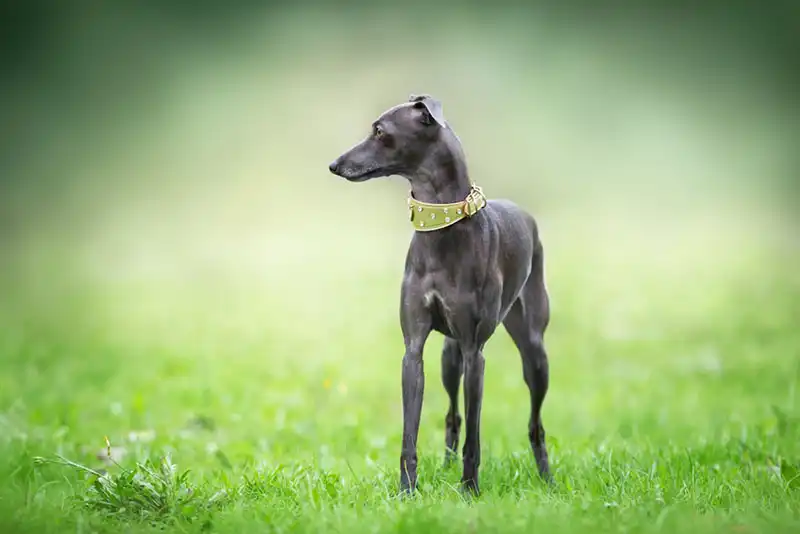
Who is this breed for?
- Italian Greyhounds are suitable for people who dream of having a dog:
- Miniature sizes;
- Non-aggressive and peaceful;
- With short hair that requires minimal grooming;
Active and sporty.
The breed is suitable for large families and single people. The main thing is to provide the animal with comfortable conditions for keeping it. Very young children do not yet understand that you cannot grab a dog abruptly and shout at it loudly. Therefore, families with babies are unlikely to be suitable for the Italian Greyhound.
This breed is not recommended for lonely people who like to sit at home. It needs walks and trips to the countryside.
Famous Owners
Many representatives of royal dynasties had Italian greyhounds: Catherine II, Julius Caesar, Cleopatra.
There is a story about how Frederick the Great, King of Prussia, hid from enemies under a bridge with his Italian greyhound during the Seven Years’ War. When the enemy soldiers were passing over the bridge, the monarch’s greyhound did not make a sound, thus saving the life of its owner.
When Frederick’s dog died, the king buried it near his Berlin palace, where the crowned heads were buried.
How to choose a puppy
If you have clearly decided on the breed, studied all its advantages and disadvantages, then start looking for breeders.
Before buying, it is necessary to study the breed standard. A baby can be assessed according to this document already at the age of several months.
For example, the color already at this age corresponds to the standard. The bite usually begins to form at an early age – it should be scissor-shaped. Although sometimes it is established in puppies only by 3-4 months.
Inspect the tail. It should be straight, without bends or bumps.
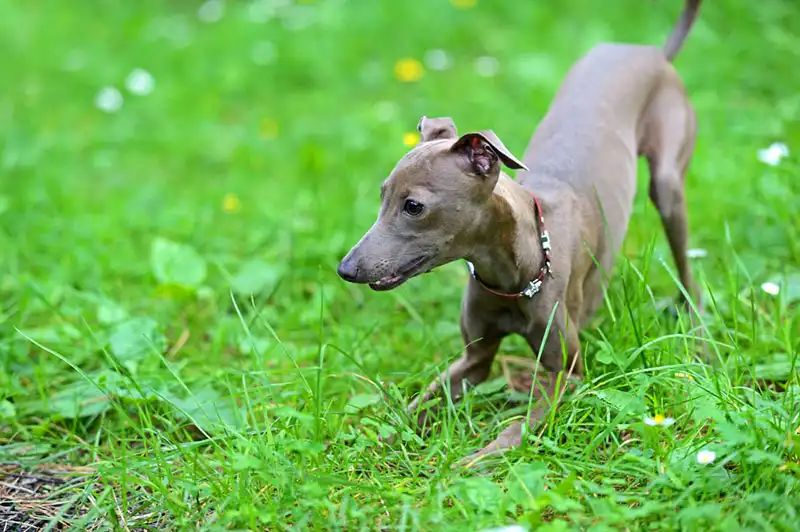
When you have chosen a male, examine his groin. A healthy individual always has two full testicles descended into the scrotum.
If you just need a pet, then pay attention to the health and character. If possible, ask the breeder about its parents. Ask to see them.
If you need a pet that will participate in exhibitions, it is better to contact only a professional nursery. Here, each buyer is provided with all the necessary documents: a veterinary passport, metrics. In addition, such organizations are sure to brand their charges or chip them. This will help identify the dog if necessary.
Don’t be shy about asking the breeder any questions you may have. An experienced specialist who has nothing to hide will always be approachable. If the breeder avoids answering, it’s best to refuse his services.
Personal experience of owners
We have studied the reviews of owners of this breed and made the following conclusions. The majority of them consider their pets:
- Balanced and docile;
- Active and athletic;
- Very similar in behavior to a cat;
- Dependent on a person;
Smart and easy to learn.
The Italian Greyhound, according to the owners of this breed, does not like cold and rain. That is why you can do without walks in the cold season. Pets easily learn to relieve themselves in a tray or on a diaper. It is imperative to buy special clothes and shoes for them.
Loves children very much, but does not tolerate bullying from them. May even express dissatisfaction.
According to the owners, this breed is active and athletic. It needs regular walks and runs.
In places not intended for walking, it is better to keep such a dog on a leash. If the dog starts chasing a cat or other animals, it will be difficult to stop it.
As most owners note, Italian greyhounds are distinguished by robust health. They rarely get sick. The main thing is to ensure that the dog does not get injured while running and jumping, and also try to keep it warm so that it does not catch a cold.
Prices for Italian Greyhounds
Italian Greyhounds are considered a rather rare breed these days, so the cost of puppies is relatively high.
We contacted breeders and found out what determines the price of such a pet. Healthy babies without a pedigree can cost 30-40 thousand rubles. In a nursery, the price is always higher – 50-70 thousand.
Dogs whose parents were winners of various exhibitions cost about 100 thousand rubles.

